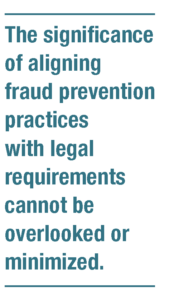Introduction
In today’s data-driven world, HR analytics has emerged as a powerful tool for organizations to gain insights and make informed decisions about their workforce. However, as organizations harness the potential of HR analytics, they must also navigate a complex landscape of legislative, regulatory, and data privacy requirements. Companies must address the ever-present threat of fraud within HR processes similarly. This article explores the considerations of data scientists and HR professionals in harmonizing these demands and ensuring fraud prevention remains a central focus. By integrating fraud prevention measures into HR analytics strategies, organizations can fortify their defenses against illicit activities, protect sensitive data, and maintain compliance.
Addressing Legislative, Regulatory, and Data Privacy Requirements
In the ever-changing data-driven landscape, businesses face a critical challenge in preserving privacy rights and data integrity. They must navigate the complex web of Legislative, Regulatory, and Data Privacy Requirements to do so. These pillars hold immense significance in data science, shaping how data is collected, processed, and protected.
Addressing Legislative, Regulatory, and Data Privacy Requirements means ensuring all data activities comply with laws, regulations, and privacy standards set by governing bodies and industry guidelines. Legislative requirements encompass laws protecting individual rights and public welfare. Regulatory requirements govern industries to maintain standards, safety, and fair practices.
However, the most crucial concern is data privacy requirements. Safeguarding personal information has become increasingly important as data has become a valuable commodity. With regulations like GDPR and CCPA, organizations must obtain consent, implement robust security measures, and offer individuals control over their data.
HR Analytics
At its core, HR analytics is applying data analysis and statistical techniques to HR-related data to gain insights and make data-driven decisions about various aspects of workforce management. By collecting, organizing, and analyzing vast amounts of employee data, HR analytics enables organizations to understand their workforce better, optimize HR strategies, and drive business performance.1
HR analytics includes but is not limited to the following areas:
- Recruitment and talent acquisition
- Employee Performance and Engagement
- Learning and development
- Compensation and benefits
- Diversity and inclusion
- Employee retention.
HR analytics uncovers patterns, trends, and relationships within HR data, providing valuable insights for decision-making, using advanced analytical methods and tools, such as data mining, machine learning, and visualization,
Role of Regulatory Frameworks in HR Analytics and Fraud Prevention
The impact of legislative and regulatory frameworks on fraud prevention efforts in HR analytics cannot be overlooked. These frameworks establish guidelines, standards, and requirements that organizations must adhere to prevent fraud and protect employee data privacy. Not adhering to these regulations may result in legal consequences, reputational damage, and financial penalties. Therefore, organizations must understand the impact of legislative and regulatory frameworks on fraud prevention and align their HR analytics practices accordingly. 2
Relevant regulations intersect with HR processes, and organizations must be aware of and comply with them to ensure effective fraud prevention. Some examples of such rules include:
- Anti-Money Laundering (AML) Laws:
Anti-Money Laundering (AML) laws aim to prevent the use of illegally obtained funds and combat money laundering. In HR analytics, organizations must comply with AML regulations when conducting due diligence during the hiring process, verifying employee identities, and monitoring financial transactions related to employee compensation or benefits. This ensures that organizations are not inadvertently involved in fraudulent activities or money laundering schemes.
- Healthcare Regulations (e.g., HIPAA):
In the healthcare sector, regulations such as HIPAA, The Health Insurance Portability and Accountability Act, regulate the protection of patient health information. HR analytics must ensure compliance with these regulations to protect sensitive healthcare data and prevent fraudulent activities related to healthcare benefits or insurance claims. By adhering to HIPAA regulations, organizations demonstrate that they are dedicated to ensuring the privacy and security of data. 3
- Data Protection and Privacy Regulations:
The General Data Protection Regulation (GDPR) applies to the European Union, while the California Consumer Privacy Act (CCPA) applies to California consumers. California imposes strict requirements on collecting, storing, and processing personal data. HR analytics must comply with these regulations to safeguard employee data, prevent unauthorized access or disclosure, and mitigate the risk of fraudulent activities stemming from data breaches. Compliance with data protection and privacy regulations helps organizations build trust with employees and ensures responsible handling of personal data.
- Industry-Specific Regulations:
Certain industries have specific regulations that intersect with HR processes and require organizations to implement fraud prevention measures. For example, the financial sector must comply with laws like the Sarbanes-Oxley Act (SOX) and regulations issued by monetary regulatory authorities to prevent fraudulent financial reporting or unauthorized access to sensitive financial data. Adhering to these regulations helps organizations maintain the integrity of financial processes and prevents fraudulent activities that can have severe consequences. 4
The significance of aligning fraud prevention practices with legal requirements cannot be overlooked or minimized. By integrating legal requirements into HR analytics strategies, organizations can establish robust fraud prevention measures that meet regulatory standards. This alignment minimizes the chances of non-compliance, legal penalties, and reputational damage. Additionally, it helps organizations foster a culture of ethical conduct, data privacy, and accountability, promoting trust among employees and stakeholders.
Maintaining Data Privacy and Security for Fraud Prevention
Maintaining data privacy and security is vital for effective fraud prevention within HR analytics. Protecting the confidentiality, integrity, and availability of HR data is crucial to prevent unauthorized access, manipulation, or misuse of data for fraudulent activities. Data privacy and security measures are the foundation for building trust with employees and ensuring compliance with regulatory requirements.
Strategies for Securing HR Data
To prevent fraud-related incidents and safeguard HR data, organizations should implement robust data security strategies, including:
- Encryption:
Employ encryption techniques to protect HR data both at rest and in transit. Encryption ensures that even if data is compromised, it remains unreadable and unusable to unauthorized individuals. Robust encryption algorithms and critical management practices should be implemented to protect sensitive HR data.
- Access Controls:
Implement strong access controls and user authentication mechanisms to limit access to HR data. Examples include role-based access control (RBAC), two-factor authentication (2FA), and privileged access management.
Potential Types of Fraud that can occur in HR Processes
Fraudulent activities can pose significant risks to organizations, undermining the integrity of HR processes and compromising valuable people and financial resources. In the context of HR, several types of fraud can occur, including:
- Identity Theft: Identity theft in HR processes involves the unauthorized use of personal information, leading to financial losses and reputational damage.
- Falsified Qualifications: Fraudulent misrepresentation of qualifications can lead to poor hiring decisions, lower productivity, and legal liabilities for organizations.
- Time Theft: Time theft involves employees manipulating work hours or attendance records for unauthorized compensation, including buddy punching and extended breaks.
- Ghost Employees: Ghost employees, added to the payroll system by insiders with HR system access, lead to unauthorized payments and financial losses for organizations.
- Unauthorized Access and Data Breaches: Unauthorized access to HR systems enables fraudsters to manipulate or misuse employee data, leading to unauthorized modifications, data disclosure, and potential data selling to external parties.
- Vendor Fraud: Employee-vendor collusion leads to kickbacks, inflated invoices, and personal benefits in procurement processes.
- Benefits Fraud: Employees commit benefits fraud by providing false claim and expense information or misrepresenting eligibility for additional help.
Importance of Incorporating Fraud Prevention Measures into HR Analytics Strategies
Effective fraud prevention measures are essential for organizations to address fraudulent activities within HR processes proactively. By integrating fraud prevention measures into HR analytics strategies, organizations can achieve the following:
- Early Detection and Prevention:
Combining HR analytics with fraud prevention measures enables organizations to identify fraudulent patterns, anomalies, and indicators at an early stage. This allows for timely intervention and preventive actions, mitigating risks before significant damage occurs. Proactive fraud prevention measures can help reduce financial losses, reputational damage, and legal implications associated with fraudulent activities.5
- Holistic View of Employee Data:
Integrating fraud prevention measures with HR analytics enables organizations to analyze employee data holistically. By considering various data points and correlations, organizations can identify potential fraud risks, patterns, and red flags that may indicate fraudulent behavior. This comprehensive perspective enhances the effectiveness of fraud detection and prevention efforts.
- Data-Driven Decision Making:
HR analytics relies on data-driven insights to make informed decisions. By incorporating fraud prevention measures, organizations ensure that recruitment, promotions, training, and compensation decisions are based on accurate and reliable information. This minimizes the chances of falling victim to fraudulent activities and promotes a culture of integrity and trust within the organization.
- Enhanced Internal Controls:
Integrating fraud prevention measures into HR analytics strengthens internal controls within HR processes. Organizations can identify potential vulnerabilities, detect policy violations, and enhance monitoring mechanisms by leveraging data analysis techniques. This promotes a culture of compliance, accountability, and integrity within the organization, reducing the likelihood of fraudulent activities and improving overall operational efficiency.
- Synergy of Expert:
Collaboration between HR professionals, data scientists, and fraud prevention teams enables the development of more accurate and effective fraud detection models and algorithms. By combining HR knowledge with data-driven insights, organizations can enhance the accuracy of fraud prediction, reduce false positives, and improve the overall effectiveness of fraud detection systems.
Organizations must foster collaboration and communication between HR professionals, data scientists, and fraud prevention teams to incorporate fraud prevention measures into HR analytics strategies effectively. This collaboration allows for the integrating of diverse perspectives, domain knowledge, and analytical expertise, leading to comprehensive fraud prevention strategies.
Importance of Clear Communication Channels
Clear communication channels are essential in addressing potential fraud cases while respecting employee privacy. Open and transparent communication promotes effective collaboration, timely response to fraud incidents, and upholds employee rights. Here are vital aspects to consider when establishing clear communication channels:
- Reporting Channels:
Organizations should establish confidential channels for employees to report suspected fraudulent activities. Employees must feel safe and protected when reporting such cases, ensuring their privacy and anonymity are respected.
- Incident Response Protocols:
Defining clear incident response protocols is crucial when potential fraud cases are reported. These protocols should outline the responsible parties involved, investigation processes, and communication procedures to handle fraud-related incidents efficiently. A well-defined and documented incident response plan helps ensure consistency, transparency, and effectiveness in addressing fraud cases. 6
- Employee Privacy Considerations:
While addressing potential fraud cases, organizations must balance the need for transparency with respecting employee privacy rights. When needed, investigations should be conducted discreetly, and the data should be shared on a need-to-know basis. Organizations must comply with applicable privacy laws and regulations to protect employee privacy during the investigation process.
- Training and Awareness:
Regular training and awareness programs should be conducted to educate employees about fraud prevention, detection, and reporting mechanisms. Transparently communicating the organization’s commitment to preventing fraud helps build a culture of trust, encouraging employees to cooperate in fraud prevention efforts actively. By promoting awareness, organizations empower employees to recognize and report potential fraud, ensuring a collective effort to prevent fraudulent activities.
Conclusion
Incorporating fraud prevention measures into HR analytics strategies is crucial for organizations to proactively address fraudulent activities within HR processes. Organizations can detect and prevent fraud effectively by leveraging data-driven insights, enhancing internal controls, fostering collaboration, and promoting a culture of trust and accountability. This integration protects the organization’s resources, ensures the integrity of HR processes, and cultivates a secure and ethical work environment. By harmonizing legislative, regulatory, data privacy requirements, and fraud prevention efforts, organizations can navigate the complexities of HR analytics while upholding ethical practices and compliance standards.
Endnotes
1 Ellmer, M., & Reichel, A. (2021). Staying close to business: the role of epistemic alignment in rendering HR analytics outputs relevant to decision-makers. The International Journal of Human Resource Management, 32(12), 2622-2642. [Google Scholar] [Publisher Link], https://bit.ly/44hLXdk.
2 Thite, M. O. H. A. N., Kavanagh, M. J., & Johnson, R. D. (2012). Evolution of human resource management and human resource information systems. Introduction To Human Resource Management, 2-34. [Google Scholar], https://bit.ly/44qSW3S.
3 Meade, R. D. (2001). Handling employees’ health information: HIPAA targets the HR department. Bus. L. Today, 11, 19. [Google Scholar] [Publisher Link], https://bit.ly/3OGx9iF.
4 Boxall, P. (2003). HR strategy and competitive advantage in the service sector. Human Resource Management Journal, 13(3), 5-20. [Google Scholar], https://bit.ly/47J79f6.
5 Baesens, B., Van Vlasselaer, V., & Verbeke, W. (2015). Fraud analytics using descriptive, predictive, and social network techniques: a guide to data science for fraud detection. John Wiley & Sons. [Google Scholar][Publisher Link], https://bit.ly/3YKLWgF.
6 Lamis, T. (2010, October). A forensic approach to incident response. In 2010 Information Security Curriculum Development Conference (pp. 177-185).[Publisher Link], https://bit.ly/3OK48Tl.



